|
|
|
Sort Order |
|
|
|
Items / Page
|
|
|
|
|
|
|
| Srl | Item |
| 1 |
ID:
161904
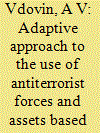

|
|
|
|
|
| Summary/Abstract |
This paper generalizes and systematizes characteristic features of armed conflicts outside Russia considering external and internal factors, as well as the typical composition and peculiarities of armed confrontation between the combat systems of the sides involving indirect actions in attendant activity areas. On this basis, the author defines the principal trends in military art and characteristic features of modern combined arms engagement.
|
|
|
|
|
|
|
|
|
|
|
|
|
|
|
|
| 2 |
ID:
159899


|
|
|
|
|
| Summary/Abstract |
Al Qaeda leaders have consistently praised the Chechen insurgents as an exemplary front of global jihad. Ayman al-Zawahiri recently applauded the steadfastness of the Chechen rebels and indicated that their resolve for jihad is worthy of emulation. Ever since the world found out about a war going on in the Muslim republic in the North Caucasus, Al Qaeda leadership has attempted to represent the Chechen struggle as one of its own battlefields. In turn, the Russian government has tried to justify its policies in the North Caucasus through demonstrating to the world that the Kremlin is fighting nothing less than Osama bin Laden’s agents in Chechnya. The North Caucasus insurgents in turn have embraced some of Al Qaeda’s narratives. While such narratives have proliferated, the factual evidence to show the direct links between the North Caucasus insurgents and Al Qaeda is still lacking. The article examines how terrorist groups such as Al Qaeda use framing for strategic ends. The evidence discussed here suggests that Al Qaeda, the North Caucasus insurgents, and the Russian government have adopted similar narratives. However, the lack of evidence to back up such narratives indicates the differences in reasons driving the convergence of the narratives.
|
|
|
|
|
|
|
|
|
|
|
|
|
|
|
|
| 3 |
ID:
124535


|
|
|
|
|
| Publication |
2013.
|
| Summary/Abstract |
This study examines Al Qaeda's organizational dynamics, doctrinal precepts, strategic objectives, operational priorities, and tactical vectors in the context of its Twenty-Year Strategic Plan. This seven-stage Strategic Plan is addressed with a particular focus on its current phase (Stage 5), 2013-2016, involving the mobilization of Muslim forces for the "Declaration of the Caliphate." In this regard, particular attention is paid to the Al Qaeda engagement in militant jihadist campaigns across the Middle East and other Muslim domains. The study concludes with an overall assessment of global threats and ongoing risks arising from the current phase of Al Qaeda's Twenty-Year Strategic Plan.
|
|
|
|
|
|
|
|
|
|
|
|
|
|
|
|
| 4 |
ID:
128975
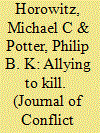

|
|
|
|
|
| Publication |
2014.
|
| Summary/Abstract |
Terrorist organizations do not operate in isolation. Instead, they forge alliances with one another, which generate a tight network of intergroup relationships. We argue that these relationships serve to increase group capacity, manifesting itself in the ability of a group to conduct deadly attacks. However, groups are notably judicious when they forge these cooperative ties, preferring to link to the strongest groups to which they have access. The result of this process of preferential attachment is a core/periphery structure in the broader network of alliances. Moreover, groups with ties to organizations at the core of the broader universe of relationships reap more rewards than those with large numbers of less meaningful alliances. Terrorism research and counterterrorism policy should assess terrorist organizations in the broader context of their interrelationships and depth of alliances rather than in isolation.
|
|
|
|
|
|
|
|
|
|
|
|
|
|
|
|
| 5 |
ID:
113530
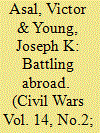

|
|
|
|
|
| Publication |
2012.
|
| Summary/Abstract |
Why are some terrorist organizations more likely to be targets of transnational counterterrorist operations? Previous work has identified characteristics of the environment or country involved to explain variation in targeting. We focus on characteristics of the violent organization to explain this variation. Using cross-national data on terrorist organizations and state targeting of these organizations, we identify several factors that help explain the variation in why some organizations are likely to be targeted while others are not.
|
|
|
|
|
|
|
|
|
|
|
|
|
|
|
|
| 6 |
ID:
095975
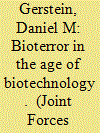

|
|
|
| 7 |
ID:
143042
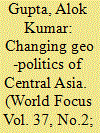

|
|
|
|
|
| Summary/Abstract |
Conflict shall neither serve the purpose of East nor even of the west, but obviously it may serve the purpose of terrorist organizations and all at the cost of severe human rights violations of the common and innocent citizens of the Central Asian region. Hence, oil, gas, geopolitics and terrorism create rigmarole.
|
|
|
|
|
|
|
|
|
|
|
|
|
|
|
|
| 8 |
ID:
152884
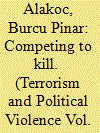

|
|
|
|
|
| Summary/Abstract |
Are organizationally linked suicide attacks deadlier than those launched by lone wolf terrorists? This article elaborates a perpetrator-based distinction among suicide terrorist attacks between organizations and lone wolf terrorists, who operate in the absence of a financially or physically supportive terrorist organization. The expectation is that terrorist organizations would serve as commitment tools that increase the loyalty of suicide bombers to their missions through material and non-material incentives. Findings demonstrate that when terrorist organizations are involved in the planning and execution of suicide terrorist attacks, not only do they increase the lethality of these attacks but they also accentuate the tactical advantages of suicide terrorism. These findings suggest that despite the recent upsurge and concern about lone wolf terrorism, the lethality and security impacts of suicide terrorism continue to be driven by terrorist organizations.
|
|
|
|
|
|
|
|
|
|
|
|
|
|
|
|
| 9 |
ID:
152885
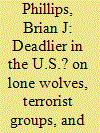

|
|
|
|
|
| Summary/Abstract |
Scholars, politicians, and pundits increasingly suggest lone wolf terrorists are substantial threats, but we know little about how dangerous these actors are—especially relative to other terrorist actors. How deadly are lone actor terrorists? A growing body of empirical research focuses on terrorist organizations, but similar work on lone actors is sparse. Furthermore, attempts to explicitly compare these or other types of terrorist actors are almost non-existent. This article considers theoretical arguments for why lone wolves ought to be especially lethal. However, it presents an argument for why terrorist groups should generally be more lethal. This argument is conditional upon the environment in which actors operate. Lone wolves should only be more deadly in states with especially strong counterterrorism capacity. The article uses data on terrorist attacks in fifteen developed countries, 1970–2010, to compare the lethality of terrorist acts. Around the world, attacks by organizations tend to be far more lethal than attacks by other actors. In the United States, however, lone wolves are generally the more lethal terrorist actors. This is argued to be because the robust counterterrorism capacity makes organized terrorism more difficult to accomplish.
|
|
|
|
|
|
|
|
|
|
|
|
|
|
|
|
| 10 |
ID:
137159


|
|
|
|
|
| Summary/Abstract |
Terrorist organizations’ physical safe havens continue to shape the terrorist threat to the United States by extending the groups’ longevity and increasing the threat they pose. As a result, eliminating terrorist safe havens has been a key component of U.S. counterterrorism policy since at least 2001. However, some scholars challenged the post-9/11 policy consensus that terrorists find sanctuary in weak states and so-called ungoverned spaces. This article seeks to bridge this gap between scholarship and policy by offering a typology for disaggregating different kinds of terrorist safe havens. Our typology operates on two axes based on host government will (i.e., the host government's posture toward each group with haven inside its borders), as well as government capability, (specifically whether the host government possesses the specific capabilities needed to oust each group). This intersection of will and capability produces three types of havens. We briefly illustrate each type of haven using the exemplar case study of Pakistan—a location often described as an overarching safe haven, but which is actually home to several sanctuaries—and offer policy recommendations for addressing them. A need exists to disaggregate and identify how the United States can approach haven elimination. This typology and the analysis that stems from it offer a starting point for devising such strategies.
|
|
|
|
|
|
|
|
|
|
|
|
|
|
|
|
| 11 |
ID:
128985
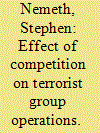

|
|
|
|
|
| Publication |
2014.
|
| Summary/Abstract |
Scholars have long accepted the contention that competition among terrorist organizations raises the level of violence used by the competitors. This article discusses this claim and advances another-that competition among terrorist organizations creates incentives to use less violence. Using insights from the organizational ecology literature-namely that competition occurs within "species"-I create a variable that assesses intraspecies competition. I test both claims using a data set of domestic terrorism created from the Global Terrorism Database (GTD) for the years 1970 to 1997. I find support for the hypothesis that competition leads to more terrorism, validating the claims of outbidding theorists. Furthermore, ideologies have differential effects on whether outbidding occurs, with nationalist and religious terrorist groups responding to competition with more terrorism and left-wing organizations responding with less.
|
|
|
|
|
|
|
|
|
|
|
|
|
|
|
|
| 12 |
ID:
112450
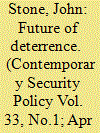

|
|
|
|
|
| Publication |
2012.
|
| Summary/Abstract |
How valuable might deterrence be for managing current and near-future threats to international peace and security? How might it work in such contexts? In 2010 a symposium was held at King's College London in order to address these questions. The participants examined a wide range of issues. A prominent concern was the extent to which the Cold War theory and practice of deterrence remains a valuable stock of relevant experience today. Specific attention was also given to the utility of conventional force as a deterrent, to the prospects for cyber deterrence, and to the feasibility of deterring non-state actors such as terrorist organizations. The participants all considered that deterrence has some role to play in Western strategy and sought to clarify what this might amount to under the specific conditions they examined.
|
|
|
|
|
|
|
|
|
|
|
|
|
|
|
|
| 13 |
ID:
095605
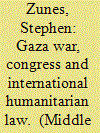

|
|
|
| 14 |
ID:
186329
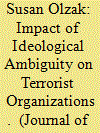

|
|
|
|
|
| Summary/Abstract |
Organizations that have a clear and unambiguous focus acquire greater legitimacy, which raises their capacity for mobilization. Using data on terrorist organizations, this paper explores two empirical implications of this claim: A terrorist organization’s survival and lethality will be threatened to the extent that it has an ambiguous ideological identity. Analyses using panel data from the Extended Data on Terrorist Groups (EDTG) test these arguments for 474 global terrorist organizations observed over 1970–2016. The key empirical predictions are that ambiguity inhibits lethality and curtails survival. This paper finds support for these claims, controlling for competition from rivals and allies, ethno-nationalist or Islamic ideological orientation, and a variety of other measures of organizational capacity.
|
|
|
|
|
|
|
|
|
|
|
|
|
|
|
|
| 15 |
ID:
182542
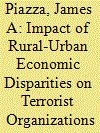

|
|
|
|
|
| Summary/Abstract |
This study investigates the influence of rural-urban economic disparities on the survival and tactical choices of resident terrorist groups. These disparities inflame social and ethnic group grievances and erode the state’s capacity to police its rural hinterlands, thereby motivating support for terrorists and providing resident terrorist groups with the ability to attack with impunity. Based on the Extended Data on Terrorist Groups (EDTG), survival analysis shows that rural-urban disparities foster terrorist group survival. Other empirical methods – negative binomial regressions and competing risk analysis – indicate how rural-urban disparities and other controls affect resident terrorist groups’ campaigns and prospects. With mediation tests, rural-urban inequalities are shown to benefit terrorist groups by increasing social group grievances and by limiting host state’s control over territory.
|
|
|
|
|
|
|
|
|
|
|
|
|
|
|
|
| 16 |
ID:
123343
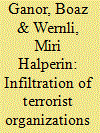

|
|
|
|
|
| Publication |
2013.
|
| Summary/Abstract |
Criminal syndicates and terrorist organizations are inherently different, one motivated by profit and the other by political goals. Yet their difference enables them to cooperate for their mutual benefit. Nowhere has this been more evident than in the drug trade; from harvesting and trafficking in illegal substances, it has been an easy transition to counterfeiting and disseminating medications. Hezbollah, in particular, has become involved in the production, smuggling and distribution of counterfeit medications in North America, Africa and the Middle East as a means of raising immense sums of money to finance its terrorist activities. Hezbollah's infiltration into the pharmaceuticals industry illustrates the danger posed by the marriage of terrorism and crime, which arises both from enhanced resources for terrorism, and from the corruption of a legitimate and necessary industry. Understanding the nature and extent of this danger is the first step in preparing to meet it.
|
|
|
|
|
|
|
|
|
|
|
|
|
|
|
|
| 17 |
ID:
187558
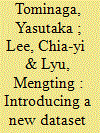

|
|
|
|
|
| Summary/Abstract |
This article introduces a new dataset, Designated Terrorist Organizations (DTO), which details every terrorist organization designated or sanctioned by two IGOs and 148 state governments, as well as the timing of each designation. The DTO includes 281 terrorist groups that have been officially designated by at least one IGO or state government as well as 223 other active terrorist groups that have never been designated. The DTO has a dyadic structure that offers information on both the designating country and the designated group, such as the base location and past activities. We present some trends and patterns of terrorist designation over time and across countries and apply the DTO to analyze the impact of terrorist designation on groups’ attacks. Our preliminary findings show that terrorist designation is negatively associated with terrorist attacks, although the effect only appears in an earlier period.
|
|
|
|
|
|
|
|
|
|
|
|
|
|
|
|
| 18 |
ID:
115356
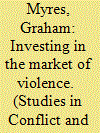

|
|
|
|
|
| Publication |
2012.
|
| Summary/Abstract |
Terrorist financing is the dedicated pursuit of adequate capitalization within a market of violence, wherein terrorist organizations seek to extract resources and funding from the social, political, and economic environment in which they operate. At the same time, the effectiveness of a terrorist group in this pursuit is highly dependent on their organizational type and design, its leadership capabilities, and its capacity for organizational learning-factors that shape the ability of terrorist groups to identify and exploit a limited set of investment and rent-seeking opportunities.
|
|
|
|
|
|
|
|
|
|
|
|
|
|
|
|
| 19 |
ID:
107646
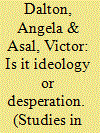

|
|
|
|
|
| Publication |
2011.
|
| Summary/Abstract |
Why do some terrorist organizations deploy women on the front lines and in violent attacks? This study explores the social conditions, economic factors, and organizational characteristics that might explain women's participation in violent terrorist activity. With a new data set of 395 terrorist organizations, women's participation in terrorist attacks was quantified and coded. The logistic regression analysis results suggest that women's educational attainment, social rights, terrorist organization's age and size, and the level of a country's economic development are important predictors of the deployment of women in terrorist violence while a terrorist group's ideological or religious orientation and the level of democracy do not significantly influence the likelihood of women's participation.
|
|
|
|
|
|
|
|
|
|
|
|
|
|
|
|
| 20 |
ID:
135600


|
|
|
|
|
| Publication |
DelhI, Neha Publishers and Distributors, 2015.
|
| Description |
288p.Hbk
|
| Standard Number |
9789380318639
|
|
|
|
|
|
|
|
|
|
|
|
Copies: C:1/I:0,R:0,Q:0
Circulation
| Accession# | Call# | Current Location | Status | Policy | Location |
| 058047 | 303.625/LOH 058047 | Main | On Shelf | General | |
|
|
|
|
|
|
|
|
|